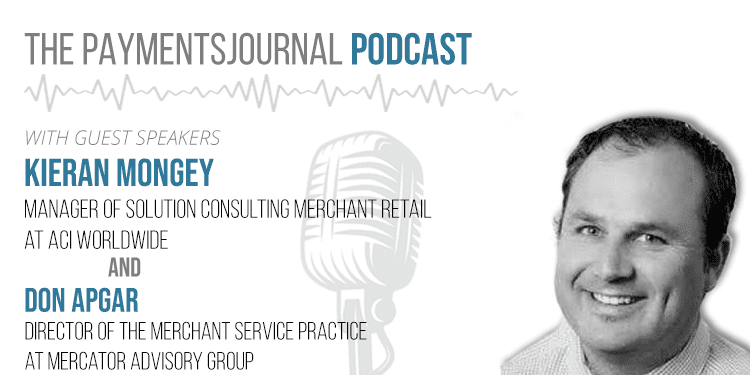Payments orchestration, or working with multiple payment providers to optimize customer conversion, enhance cost savings, and improve fraud prevention processes, is a hot topic in the world of e-commerce. Merchants are increasingly recognizing the value of taking a multi-provider strategy approach to payments.
To learn more about the benefits of payments orchestration, PaymentsJournal sat down with Kieran Mongey, Manager of Solution Consulting Merchant Retail at ACI Worldwide, and Don Apgar, Director of Merchant Services Advisory Service at Mercator Advisory Group.
Merchants cite multiple advances of a multi-provider approach to payments.
Payments orchestration enables merchants to work with multiple payment providers to optimize payments from start to finish. “Orchestration is the ability to drive a strategy in payments that helps abstract the complexity of managing multiple payment providers while putting in place a framework for optimization and allowing payment managers to shift their focus from operational to strategic tasks,” defined Mongey.
According to an API Worldwide merchant survey, the top three advantages of a multi-provider approach to payments are flexibility, cost optimization, and access to multiple best-of-breed capabilities. In fact, 50% of merchants surveyed by ACI Worldwide see flexibility as the primary benefit of a multi-acquirer approach. 44% of merchants cited cost optimization and 43% cited best-of-breed capabilities as top advantages to their multi-provider approach.
“With that flexibility and cost [savings] is that concept of offering the best-of-breed multiple vendors that really specialize in those more complex aspects of payments and payments orchestration,” said Mongey.
Forming partnerships with multiple acquirers prevents merchants from being locked into a single vendor. “Long gone are the days when you went out to bid and picked an acquirer or processor… that checked most of your boxes and [you] had to make do with what you couldn’t get. Now, intelligent routing and software has made it easier for merchants to use a host of services across multiple platforms to get everything they need and to apply it as a transaction dictates,” explained Apgar.
A growing volume of interest in orchestration
From the checkout experience to payment type acceptance, regulatory compliance, and cost control, payments orchestration can touch upon every aspect of the payment process. Merchants are increasingly recognizing the value that it can offer, from reducing operational costs to enabling global coverage.
“When you’ve got an orchestration layer in your tech stack, that enables you to distribute that to the path where it’s executed in the best way… so you’re not in the weeds all the time trying to solve problems,” said Apgar.
Without orchestration, it is easy to lose sight of the big picture. “We often get bogged down into day-to-day operational processes, and as payment experts, we should be really thinking more strategically about the customer journey, the investment, the APIs, the partnerships that we run in payments, maybe consolidating some of that when appropriate and really focusing on payment optimization. And what that means is ultimately it’s around customer conversion and then cost to operate,” added Mongey.
The tangible benefits of an orchestration approach
The benefits of orchestration largely fall into three key areas: cost, growth, and conversion. In each of these areas, merchants can identify and quantity the value that orchestration delivers to their bottom line.
ACI Worldwide has already seen firsthand how companies benefit from payments orchestration. “In our own implementation and strategic development, we have [gotten] some fantastic case studies that talk to orchestration,” said Mongey. For example, one global merchant that shifted to a local acquirer saw a 42% uplift in bank approvals based on dispatching logic and orchestration. Meanwhile, a large apparel merchant adopted multiple fraud vendors and reduced fraud declines by 22%; that same global apparel merchant also saw a 13% uplift with smart retry.
“Then you’ve got other elements, like the speed to market and the cost. There’s no cost to develop, for the most part, these initiatives because it’s all embedded into the orchestration layer,” noted Mongey. “The ability to just switch that on and be first to market and beat the competition is even sometimes difficult to quantify, but extremely important.”
Apgar further unscored the importance of beating out competition, adding that “it’s really about driving sales. It’s really about driving conversion, because an uptick in sales will outweigh a reduction in cost any day of the week.”
Key features for payments orchestration
A multi-acquiring payments orchestration approach gives merchants the choice of which payments providers they want to work with. ACI Secure eCommerce, ACI Worldwide’s payments gateway for cross-border commerce, is one of those options.
ACI Secure eCommerce is an agnostic technology stack payment layer that allows merchants to choose from multiple acquirers globally, provides best of class fraud prevention, and offers one API to integrate all channels, features, and global coverage for cost control.
It also offers a seamless front-end experience for customers. “That’s what the digitization that we’ve seen in the past two years, especially with COVID, [has been about.] The customer expectation has risen significantly about how they want that payment experience to be. Ultimately, they don’t want it to be anything. They just want it to happen,” added Mongey.
Additionally, ACI Worldwide’s machine learning and artificial intelligence is equipped with incremental learning, meaning it can learn based on the most recent subsets of data. As a result, it becomes more efficient and in tune with customer trends as they occur.
“That’s what we’re here to deliver in terms of a solution set and a platform, and what we work constantly [on] with our very large global merchants… What it looks like today, versus where it’s going to be in 12 months and where it was 12 months back, is an amazing journey [of] constant development. And that’s why a payment partner is such a critical decision for a merchant to make,” concluded Mongey.

